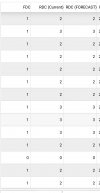From reading your post, it would appear that your are using "Group Dynamics" to reach an objective point.
"Group Dynamics" is when you have a number of people who are willing take up certain positions/roles/work within a process to achieve a desired outcome. In other words they not only work well together, but compliment each other in their strengths and weaknesses. The problem is that change within the group quickly leads to the end of such success.
Examples are sports teams, fire fighters, and other crews who by working together not only achieve, but excel amongst their peer groups.
It looks good now, but is not sustainable, nor practical, and could lead to some serious problems down the road when it comes to the inbound process.
Here's the first litmus test I had to do to see if I was engaging in this practice.
First measure your current process outcome.
Second, rotate all your team into a different position for one week and measure the outcome.
Third, repeat until all the team has experienced every work area.
If you have actually improved upon a process, your numbers at the end of each rotation will mirror your original process measurement. If not, you have used "Group Dynamics" to reach a desired outcome.
From what I recall, Target does not have a team member profile requirement for the inbound process. So all team members, unless Target has made specific arrangements for, should be able to perform all inbound task.
"Group Dynamics" is an acceptable practice in certain organizations, but not at Target. We're not compensated in that manner.

